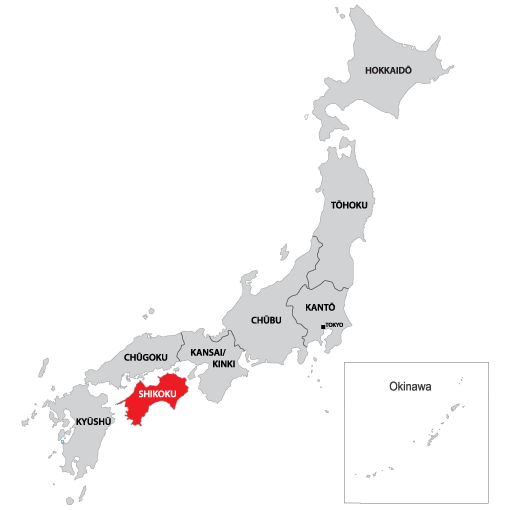
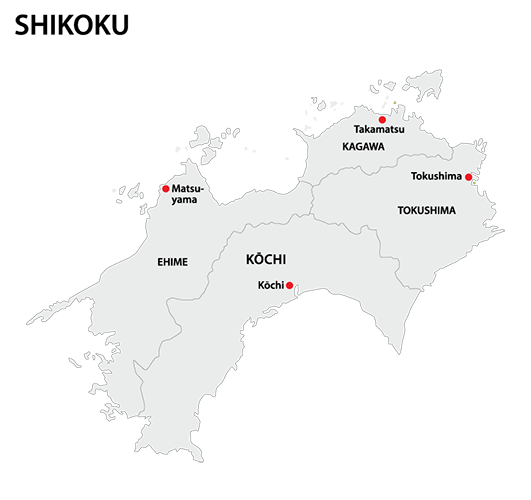
Shikoku is the smallest of Japan's 4 main islands
It takes its name, the ‘four provinces’ from the original Awa, Tosa, Sanuki, and Iyo provinces making up the island – but the island is now divided into the four modern-day prefectures of Tokushima, Kochi, Ehime, and Kagawa. North of the island lies the Seto Inland Sea, between Shikoku and Honshu and bordered to the West by Kyushu. To the south of Shikoku lies the Pacific Ocean. The island is known for its natural beauty of forests, mountains, rivers, and dramatic shorelines. Overall, the island is known for its 88 Temple Pilgrimage route, or Shikoku Junrei a Buddhist route of pilgrimage that is still followed by devotees o-henro, today. The island is connected to the mainland by three main bridges. The island has a mild climate and the variety of its geography means it is also blessed with wonderful produce that has been harnessed in the local food culture. The island retains far more of a rural feel than the other islands of Japan.
Tokushima Prefecture
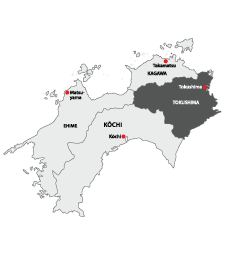 For many crossing the bridge from the Kansai area via Awaji Island, Tokushima is the entry point to Shikoku. The Naruto strait between Awaji Island and Tokushima prefecture is famous for its whirlpools, a consequence of tidal swells of the fast current moving through the narrow strait. The curious can view this phenomenon from small boat cruises, or an observation point on land. Naruto is so famous for its whirlpools that the swirled fish paste of pink and white whorls is known as Naruto fish paste. Tokushima city is also well known for the Awa Odori, dances with a 400-year history that take place during the O-bon festival. It is a time when residents tend to the graves of their ancestors and welcome them back for their short visit from the afterworld to the physical plane. The dances take place in the evening throughout O-bon. Visitors coming to Tokushima outside of the O-bon period can visit the Awa Odori Kaikan, where they can learn about the dances and see demonstrations.
For many crossing the bridge from the Kansai area via Awaji Island, Tokushima is the entry point to Shikoku. The Naruto strait between Awaji Island and Tokushima prefecture is famous for its whirlpools, a consequence of tidal swells of the fast current moving through the narrow strait. The curious can view this phenomenon from small boat cruises, or an observation point on land. Naruto is so famous for its whirlpools that the swirled fish paste of pink and white whorls is known as Naruto fish paste. Tokushima city is also well known for the Awa Odori, dances with a 400-year history that take place during the O-bon festival. It is a time when residents tend to the graves of their ancestors and welcome them back for their short visit from the afterworld to the physical plane. The dances take place in the evening throughout O-bon. Visitors coming to Tokushima outside of the O-bon period can visit the Awa Odori Kaikan, where they can learn about the dances and see demonstrations.
Tokushima city is also the starting point of the 88 Temple Pilgrimage route, associated with Kukai or Kobo Daishi, a religious and historical figure. Ryozen-ji temple, as the first temple on the route, outfits pilgrims as they embark on their journey with the identifying garments. The overall pilgrimage route circles the entire island of Shikoku in a 1400km route. Given its duration, many modern pilgrims will visit smaller sections of the route at a time and may make the pilgrimage by car rather than on foot as was traditional. Temples 1 through 22 and 66 are located in Tokushima prefecture. There is a longstanding local practice of o-settai or offering hospitality to those on the pilgrimage, whether that is as simple as offering a lift, some sweets, or even a meal or a bunkhouse they may have built to assist pilgrims in the very remote sections.
Local to Eastern Tokushima, Otaniyaki pottery is known for its large size, but smaller dishes are also made for daily use. Otani ware is produced in a unique team fashion due to its large size – with one potter turning the wheel with his feet and another working the clay – to produce vessels that were associated with natural indigo dyeing. Indigo dyeing, or Aizome, persists as a local art form today, though on a far smaller scale than in previous centuries as the process of using plants to produce the rich blue color is still known in many parts of the world as ‘Japan blue’ is a laborious one. During the Edo period, indigo dyeing put Tokushima on the map. Wakimachi and its townscape of traditional buildings and udatsu walls that acted to prevent the spread of fires between buildings is evidence of the wealth created.
Western Tokushima has a far more rural feel. The small town of Miyoshi forms the jumping-off point for the remote dramatic landscapes of the Iya Valley. The fast-flowing Yoshino river features clear clean waters that descend from the mountains above. The steep Oboke and Koboke gorges and their rapids are well suited for white-water rafting. In the Iya Oboke area, hot springs at river level provide an opportunity to view the river from an onsen. The village of Ochiai seems to defy the steepness of the mountainside on which it is perched. This farming village still maintains a small aging community. The ‘scarecrow village’ of Nagoro faced such a drastic reduction in population that local people have created slightly spooky life-sized scarecrows of former and current residents – complete with a classroom of schoolchildren. Further along the valley, examples of the vine bridges that spanned the steep gorges remain suspended above the rivers. While but a few remain today, they were once the primary means for crossing the swift rivers. These remote valleys still are home to many descendants of the Heike clan, who fled here in the aftermath of the Gempei wars at the end of the Heian period in the 1100s. Other members of the clan dispersed to other mountainous and remote areas of Honshu. Tsurugi san is the second-highest mountain in Western Japan. It is possible to ascend here by cable car and then hike along the ridgeline at the top of the mountain. On a clear day, hikers are rewarded for their efforts with expansive views.
The coastline of Southern Tokushima is famous for its surfing, particularly at Kaifu Point and Kaiyo. Throughout the summer months, from May to August, loggerhead turtles come ashore to Ohama beach to lay eggs and hatch their young. Cape Kamoda features open-air hot springs and beautiful views over Awaji Island at this Westernmost point of the island. Further inland the Tairyu-ji cable car offers magnificent views over the surrounding valleys as it makes its way to the remote mountain top temple Tairyu-ji – 21st of the temples on the 88 Temple pilgrimage route. Todoroki falls are one of Japan’s top 100 waterfalls. They are located on the Kaifu river and visiting some of the uppermost falls requires a hike inland.
Kochi Prefecture
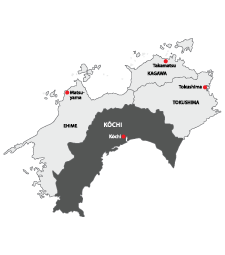 Stretching Southern Shikoku from East to West is the crescent-shaped prefecture of Kochi. Kochi was home to Sakamoto Ryoma, a samurai who was a driving force in the political changes that led to the modernization of Japan. Eastern Kochi finishes at its southernmost point with Cape Muroto, home to The Muroto UNESCO Global Geopark. The subtropical setting includes unique geographic features such as turbidites caused by tectonic activity. At the cape, visitors can see not only the lighthouse and Hotsumisaki-ji temple, but also the Mikurado caves where Kobo Daishi, or Kukai, was said to achieve enlightenment. The small village of Kiragawa still retains preserved areas of the old townscape.
Stretching Southern Shikoku from East to West is the crescent-shaped prefecture of Kochi. Kochi was home to Sakamoto Ryoma, a samurai who was a driving force in the political changes that led to the modernization of Japan. Eastern Kochi finishes at its southernmost point with Cape Muroto, home to The Muroto UNESCO Global Geopark. The subtropical setting includes unique geographic features such as turbidites caused by tectonic activity. At the cape, visitors can see not only the lighthouse and Hotsumisaki-ji temple, but also the Mikurado caves where Kobo Daishi, or Kukai, was said to achieve enlightenment. The small village of Kiragawa still retains preserved areas of the old townscape.
Heading towards central Kochi prefecture are the Ryuga limestone caves – 4km long and geographically significant. Kochi city is a castle town, and one of the few that retains most of the structures of its main building. The city also is home to sites commemorating native son Sakamoto Ryoma, a low-ranking samurai who was part of the force that restored the power of Emperor Meiji over that of the Tokugawa Shogunate. You’ll find a museum dedicated to his short life as well as associated sites. The city itself has a vibrant Sunday market, with foodstuffs, household goods, and antiques. The Hirome market in the city also offers restaurants serving Kochi and Shikoku specialties. It is a great location to try out Bonito Tataki or seared bonito and local Tosajiro chicken. At the seafront, the Katsurahama beach offers beautiful views and is known as a key moon-viewing location. Nearby Chikurin-ji temple offers an island of calm and tranquility, and indeed, temples 24 through 39 of the 88 Temple pilgrimage route are found in Kochi. In contrast to the tranquility of these temples, in August of each year, the Yosakoi festival takes place and dance troupes from all over the country converge on Kochi for a lively and energetic dance festival.
Kochi is also known for its natural beauty. Further inland and northwest of Kochi city is the Niyodo river – famed for the diversity of color caused by its exceptionally clear water and the refraction of light. The Shimanto River also boasts some of the cleanest and most pristine waters in Japan. The Shimanto offers a variety of water sport possibilities – SUP, canoeing, kayaking, and rafting. The river is crossed in some places by ‘sinking’ or chinkabashi bridges – bridges without any side railings that are designed to survive river flood crests. The area is also popular for fishing given the ayu and other river fish that thrive in the river’s clear waters. Continuing west from the mouth of the Shimanto River and south leads to cape Ashizuri, Shikoku’s southernmost cape is as wild as its eastern counterpart in the prefecture.
Ehime Prefecture
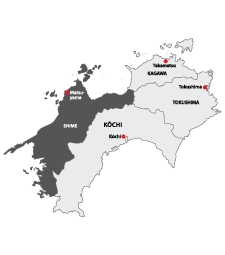 Traveling clockwise around the island of Shikoku, one comes next to Ehime prefecture. In Southwestern or ‘Nanyo’ Ehime, Uwajima was the base of the powerful Date family. Uwajima Castle is one of the few remaining original Edo period castle keeps in Japan. A museum dedicated to the family tells of their importance in the area and preserves more notable family possession, and the Tensha-en landscape garden is another legacy of the Date family.
Traveling clockwise around the island of Shikoku, one comes next to Ehime prefecture. In Southwestern or ‘Nanyo’ Ehime, Uwajima was the base of the powerful Date family. Uwajima Castle is one of the few remaining original Edo period castle keeps in Japan. A museum dedicated to the family tells of their importance in the area and preserves more notable family possession, and the Tensha-en landscape garden is another legacy of the Date family.
Rural traditions remain alive in this part of Shikoku. Traditional bullfights still take place in Uwajima where two bulls are pitted against each other in a decidedly more animal version of sumo. Taga Jinja, a shrine located in Uwajima, celebrates longevity and fertility with appropriate statuary and carvings. Nearby Ozu town has a restored castle, and some historic streets harking back to the Edo and Meiji periods of Japan’s history remain. Garyu Sanso, an elegant country villa, sits above the Hijikawa River in stately fashion. Built by a local trader, it incorporates design and architectural elements that would not be out of place in the Imperial villas in Kyoto.
The geography of this part of Ehime is shaped by a glacial past, and in the Shikoku Seiyo Geopark, you’ll find the Shikoku karst plateau. The many gorges in the area lend themselves to canyoning or rafting. The park extends to the sea, to areas that are a heaven for those interested in watersports such as snorkeling, windsurfing, and sea kayaking. Along the coast and inland in the mountains, it is possible to walk between temples of pilgrimage. The Nametoko gorge is a haven for local wildlife.
Heading further north brings you to Uchiko, a town that made its fortune on plant-based waxes and candles produced from them. The Yokaichi Gokoku preserved district retains the trappings of this wealth – beautiful Edo and Meiji period homes and the Uchikoza kabuki theater. The Izumidami rice terraces lie east of Ozu and Uchiko, hugging the steep mountain, with the bright sunlight shimmering on the surface of the paddies as tender shoots of rice stretch to the sun.
Chuyo or central Ehime is home to the Kuma Kogen and Ishizuchi areas of natural beauty. Ishizuchi is the highest peak in Shikoku and one of the seven sacred peaks of Japan. The ascent is unforgiving, accessed using chains for the ascent of the steep peak. The Kuma Kogen surrounds Ishizuchi and borders Kochi prefecture. The Omogo gorge lies at the foot of Ishizuchi and features brilliantly clear waters.
Matsuyama is the largest city in Ehime prefecture, and indeed on the island of Shikoku. The star for many is the neighbouring Dogo Onsen area. Dogo Onsen’s bathhouse was the inspiration for Studio Ghibli’s bathhouse in Spirited Away. As is common to onsen resort areas, there are plenty of shops and boutiques in the area for visitors to while away the hours between soaks. Asuka no yu is a new public bath in Dogo Onsen, but you’d be forgiven for thinking it is an older building as it was built in the Asuka style. The hot springs lying beneath Dogo Onsen feed many ryokans in the surrounding neighbourhood.
Matsuyama has literary associations, as the setting for the Japanese novel Botchan. The Botchan Train, a restored steam train, takes its name from the novel’s protagonist and makes its way through the town periodically to the delight of locals and visitors alike. Matsuyama castle sits high above the city and is another of Shikoku’s original castles. Visitors can ascend on foot or by cable car. Isaniwa Shrine and Ishite-ji temple are historic spiritual buildings in the Dogo Onsen area, and the latter of these is a popular temple on the island’s pilgrimage route. Dogo Onsen also has a sake brewery and a long tradition of indigo dyeing, a traditional craft on Shikoku. With so much coastline, it is not surprising that taimeshi, or rice cooked with red snapper, is a local specialty.
Toyo or Eastern Ehime is home to Imabari, a town on the coast that is on the Shikoku side of the Shimanami Kaido. The Shimanami Kaido is a 60 km cycling route over the bridges crossing the Setouchi Inland Sea from Honshu to Shikoku. It is possible to cycle from one end of the bridge to the other, stopping at islands of the Inland Sea en route. The area is not just popular with cyclists – the more protected waters of the Inland Sea are also suitable for sea kayaking. Omishima Island, along the Shimanami Kaido, is home to the Oyamazumi shrine, one of Japan’s largest and one of the oldest forest shrines in the country, associated with Emperor Jimmu. It’s the main shrine of the Mishima and Yamazumi shrines. A 2600-year-old tree stands on the grounds of the shrine. Also on the island is one of Japan’s largest museums of armor and swords. Imabari is famous throughout Japan for the production of absorbent towels and is a popular souvenir of the region. Imabari Castle is one of the few in Japan with a saltwater moat, owing to its seaside position. This reconstructed castle offers views of Setouchi.
Kagawa Prefecture
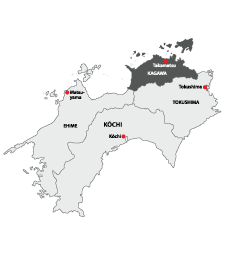
Kagawa prefecture is located in the northeast of the island of Shikoku, and while it may be Japan’s smallest prefecture, it does pack a punch. It is located on the Setouchi Inland Sea and includes many smaller islands. Heading East from Ehime will bring you to Chichibugahama beach, known for its low tidal flats that reflect the sky above. It is particularly popular with photographers at sunset as the light can create a near mirror image of the sky above in the standing shallow pools of water below.
Zentsuji Temple in Kagawa prefecture, is one of the most important temples of the 88 Temple Pilgrimage route, as it is the temple where Kobo Daishi (Kukai) was born and the temple itself was said to have been built by him. Marugame Castle in the area sits atop Mt. Kameyama. It is one of the few remaining original castles in Japan and was likely protected not just by its position, but by its 60m high stone walls and moats surrounding the edifice.
The onsen town of Kotohira is due south from Marugame. Kotohira-gu is a shrine accessed by over 1300 steps to the innerIzutama-jinja shrine. Those that make the ascent are rewarded by views over Kotohira. Sailors and those that make their lives from the sea pray for protection here as the shrine is dedicated to the souls taken by the sea. Known more formally as Komipirasan, the shrine is the head of all Kompira shrines.
Kabuki was a well-loved form of entertainment on Shikoku, and below Kotohiragu is the Kanamaruza kabuki theater. This historic building still hosts performances today, but a special treat of a visit is the opportunity to look backstage for a taste of what happens behind the scenes at a performance.
Kagawa is also famous for its udon, and there are restaurants throughout the prefecture offering this simple but delicious local specialty. You can even learn how to make udon. Takamatsu is famous for its sanuki udon – where the chewy noodles are eaten with a dipping sauce or in a dashi stock made from sardines. Diners can also enjoy kamaage udon – served within its cooking water for the ultimate expression of udon and a celebration of it in its simplest and purest form.
Takamatsu has more to offer than udon. Ritsurin Garden is a beautiful strolling-style Japanese garden that once lay on the grounds of the Matsudaira families home. The garden is large, dotted with hills, teahouses, and koi-filled ponds offering constantly changing vistas. East of the downtown core, the Shikoku Mura open-air museum is a collection of architectural styles of Shikoku. Most of the buildings are from the Edo and Meiji periods and include industrial buildings. For those seeking modern sculpture, the Isamu Noguchi Garden museum houses several works by the sculptor in his later years.
Takamatsu is also a transportation hub for ferries to the larger islands of the Eastern Inland Sea. Naoshima has quickly risen to international prominence as an unlikely pilgrimage site for aficionados of modern art. This small island hosts the Setouchi Triennale every three years when the permanent museums and installations on the island are supplemented by additional works. Installations can also be found on nearby Teshia Island. In between the events, visitors can discover the works of Benesse House, The Lee Ufan Museum, and the Chichu Art Museum, all of which are celebrated for their architecture by Japan’s enfant terrible Ado Tadao, as much as for the art they exhibit. You may also wish to take some time to enjoy a bath in the ‘I Love Yu’ sento art installation. You’ll also find the dotted pumpkins associated with Yayoi Kusama positioned on piers overlooking the sea.
Shodoshima, one of the largest islands on the Inland Sea, is known for its seemingly incongruous olive groves, its soy sauce factory, and is also a venue for the Triennale. Shodoshima has its own 88 temple pilgrimage route. Inland are the beautiful Shodoshima senmaida rice terraces and the Kankakei gorge, which runs through the centre of the island with steep rock cliffs. The ropeway running through the gorge provides views both of the gorge and also the Inland Sea.
